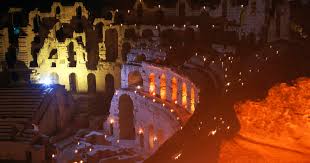Amphitheatre of El Jem, Tunisia
🏟️ Amphitheatre of El Jem: Tunisia’s Timeless Colosseum
Tucked in the heart of Tunisia's Sahel region lies a colossal surprise: the Amphitheatre of El Jem — an ancient Roman marvel so imposing and well-preserved, it rivals the Colosseum in Rome. Rising out of the modest town of El Djem like a ghost of imperial grandeur, this UNESCO World Heritage Site is a must-visit for travelers drawn to history, architecture, and cinematic landscapes.
Built in the 3rd century CE, El Jem’s amphitheatre was once the jewel of Roman Africa, capable of seating an astonishing 35,000 spectators. Today, it stands as one of the most intact Roman structures of its kind anywhere in the world. And yet, unlike many over-touristed ruins in Europe, El Jem invites a kind of quiet intimacy — allowing you to wander through its echoing arches and underground chambers almost undisturbed.
🏛️ Historical Echoes: A Monument of Power and Pride
The amphitheatre was constructed during a time when Thysdrus (modern-day El Jem) was a prosperous Roman city, enriched by olive oil trade. With wealth came ambition, and the people of Thysdrus built a structure that would rival the grand arenas of Rome.
Though its architect remains unknown, the amphitheatre reflects the scale and vision of the Roman Empire — towering at 36 meters high, with three tiers of seating and an elaborate system of corridors and trapdoors. Gladiatorial contests, wild animal hunts, and public spectacles once roared through its arena, uniting the city in both entertainment and imperial identity.
🧱 Architectural Grandeur: An Engineering Masterpiece
El Jem's amphitheatre is not only grand in scale — it's brilliant in design. Built entirely of stone blocks without mortar, the structure’s harmony and durability are extraordinary. Massive elliptical arches form perfect symmetrical layers, while staircases spiral into the heavens. Its amphitheatre plan is oval, measuring about 148 meters long and 122 meters wide — just slightly smaller than the Roman Colosseum.
What makes it stand out even more is how well-preserved it is. Unlike Rome’s Colosseum, which has suffered both time and plunder, El Jem remains structurally sound, with much of its original façade intact. Visitors can climb up to the very top tiers, descend into the arena, or venture below into the hypogeum, where animals and gladiators once awaited their fate.
🎬 Cultural Legacy: From Gladiators to Hollywood
El Jem has long captivated storytellers and filmmakers alike. It served as a backdrop in the 1979 film Monty Python’s Life of Brian and inspired scenes in Gladiator (2000). But the amphitheatre is not just a static ruin — it remains a living venue, hosting music concerts, art performances, and the annual El Jem International Symphony Festival, where classical music reverberates through ancient stone under a summer sky.
🧭 Getting There & Orientation Tips
El Jem is located roughly 200 kilometers south of Tunis and is accessible by train, bus, or private car. The train journey from Tunis takes about 4 hours and is an affordable and scenic option. Alternatively, renting a car provides more flexibility and the chance to explore nearby towns like Mahdia or Sousse.
Once you arrive, the amphitheatre is hard to miss — it dominates the small town’s skyline. The town itself is quiet and walkable, so you can easily explore on foot.
🎟️ Visitor Information & Tickets
-
Opening Hours: Daily from 8 AM to 7 PM (summer), 8:30 AM to 5:30 PM (winter)
-
Admission: Around 12 TND (with combined access to the nearby El Jem Museum)
-
Guide Tip: Hire a local guide or audio tour to enhance the experience; the site has minimal signage.
Don’t skip the El Jem Archaeological Museum, located a short walk away. It houses exquisite Roman mosaics and artifacts recovered from villas in the region.
📸 Best Views & Photo Spots
-
Climb to the highest tiers for panoramic views of the arena and the town.
-
Stand in the center of the arena for a powerful, gladiator’s-eye perspective.
-
Explore the underground passages where shadows and shafts of light create a cinematic atmosphere.
Bring a wide-angle lens or a drone (where permitted) to capture the full majesty of the site.
🍽️ Where to Eat & Stay
While El Jem is small, it has a few charming spots for a post-exploration meal:
-
Hotel Julius – A café-hotel hybrid offering local dishes with amphitheatre views.
-
Restaurant Sabri – Simple, traditional Tunisian food and friendly service.
-
Local street vendors – Try brik (fried pastry), couscous, or mint tea on-the-go.
For accommodations:
-
Hotel Julius or Maison d'Hôte Dar El Jem offer authentic, modest stays with proximity to the ruins.
-
Alternatively, base yourself in Mahdia or Sousse for beach access and larger hotel options.
🗓️ When to Visit & Travel Tips
-
Best Time: Spring (March–May) and Autumn (September–November) for cooler temperatures and clear skies.
-
Summer can be extremely hot — bring sunscreen, water, and a hat.
-
Wear sturdy shoes for climbing and exploring uneven stone paths.
-
Combine your trip with visits to Kairouan, Mahdia, or Sousse for a deeper Tunisian experience.
🌅 Final Word: Why El Jem Belongs on Your Bucket List
El Jem’s amphitheatre is more than a ruin — it is an experience suspended between grandeur and silence. It whispers of ancient glory without the noise of mass tourism. You don’t just see it; you feel it — the chill of underground cages, the dizzying scale of the arena, the fading echoes of cheers and steel.


